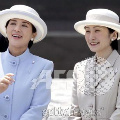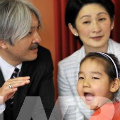Prince and Princess Akishino on Goodwill Tour
Prince Akishino and Princess Kiko are presently on a two-week goodwill tour of Europe that began in Austria and took them in the following to Bulgaria and Hungary. The fourth and last leg of their journey is going to be Romania. The visits are taking place in order to celebrate the 140th year of Japanese diplomatic ties with Austria and Hungary and the 50th year since Tokyo resumed formal relations with Bulgaria and Romania.
Last Thursday the couple was welcomed by Bulgarian President Georgy Parvanov and his wife Zorka at the Presidential Palace in Sofia. On Friday, the prince and Parvanov were to open a replica of a famous Thracian tomb, funded by the Japanese government. On the royal programme were also visits to the golden-domed Alexander Nevski cathedral in Sofia and the Boyana Church, a UNESCO World Heritage site. At 18th secondary school “William Gladstone” as well as at Sofia University the prince and princess met with pupils, students and lecturers in Japanese studies.
On Saturday, the royal couple were received by Bulgaria’s former king and premier Simeon Saxe Coburg and his wife Margarita (Article) before they travelled on to Hungary where they visited an exhibition of Japanese design in Budapest’s Museum of Applied Arts. (Article) They went to see the Budapest Zoo and the Hungarian Museum of Agriculture on the following day. On Monday they met with Hungary’s President Laszlo Solyom who discussed environmental issues with his guests before presenting them with presents of a Herend porcelain bird and a zither.
Yesterday, Prince and Princess Akishino arrived on the fourth leg of their tour, in Romania, where they were scheduled to visit the Japanese School before meeting with Romanian President Traian Basescu and his wife Maria today at Cotroceni Palace in Romania’s capital Bucharest. (Article)
Prince and Princess Akishino are the parents of the only boy, which means under Japan’s male-only succession law: the only heir to the throne, in the youngest generation of the imperial family. When the princess delivered her third child, due to complications by a Caesarean section, on September 6, 2006, just a few days before her fortieth birthday, and when it turned, indeed, out to be a boy (which most spectators, incidentally, had it expected to be), this event put an end to all plans to revise the succession law and allow a woman to ascend the Japanese throne.
In the following press comments, few journalists failed to draw comparisons between Princess Kiko and her sister-in-law, Crown Princess Masako, and to represent their characters as being completely opposite. Depending on the writer’s sympathies, this would sound, from the “Kiko-fans”, like: “Selfish, self-assertive, westernized career woman” (Masako) and “Paragon of modest femininity who dutifully sacrifices herself to uphold ancient Japanese tradition” (Kiko), and from the “Masako-fans”: “Brilliant crown princess who has it all to lead the Japanese monarchy into the 21st century” (Masako) and “Opportunistic, old-fashioned housewife who cannot think for herself” (Kiko). But as this is not a Hollywood movie but real life, it becomes, unfortunately, soon clear, when taking a closer look at both princesses, that although there are certainly differences between them, they have, in fact, many things in common.
True, Princess Kiko has never had a career of her own as she got married when she was still a student (whereas Masako pursued her career in the foreign service with so much enthusiasm that the prospect of quitting it made her hesitate a very long time before she finally accepted Prince Naruhito’s marriage proposal). But the sisters-in-law have, both, graduated from universities where their fathers were teaching, Masako from Harvard and Kiko from Gakushuin, Masako in economics and Kiko in psychology. Remarkably, Kiko even continued her studies after her marriage which is uncommon in Japan – but rather common in Austria where she attended school. That means that we can find in Kiko’s biography as well as in that of Masako traits of Western influence, and in fact, although it is hardly ever mentioned, the “traditional” Kiko passed, as a child and teenager, much time abroad (due to her father’s career), just as Masako did: Kiko has been living in the US and in Austria, Masako in Russia and the US. Accordingly, both are fluent in several foreign languages.
It has to be admitted that those who call Kiko traditional have a point in so far as, when she consented to get pregnant for the third time, although the birth of her last child had taken place already 12 years ago, she was undoubtedly fulfilling the most traditional of duties of a Japanese princess: to produce an heir. And what is more: without her getting pregnant, even without her pregnancy having been so uncommonly early published (when she was only six weeks pregnant), the bill to allow a woman to succeed the throne would, in all probability, already have passed in parliament. And then her little son would have been, on the day of his birth, but fourth in line to the Japanese throne, after his cousin Princess Aiko and his father, Prince Akishino, which would have given him but a very small chance of ever succeeding it.
It was definitely Princess Kiko who effectively “protected” the Japanese throne from being ascended by women in the future and – especially – by their offspring. Without her, the small but powerful rightwing minority that vehemently opposed the imperial succession to be passed on through the female line, would, at last, have been obliged to give in. Although they had solutions of their own to the succession crisis, either the resurrection of other branches of the imperial family which had been abolished after World War II, in order to find a distant relative of the emperor with the right Y chromosome, or the revival of the concubine system (a proposal of Prince Tomohito of Mikasa, a cousin of the current emperor), none of these possibilities would have been acceptable to the vast majority of Japanese, most of whom were supportive of Princess Aiko ascending the throne. So, Princess Kiko’s pregnancy actually was the last stronghold of Japan’s ultranationalists.
But, on the other hand, the way in which Princess Kiko made use of her newly acquired popularity as mother of the future heir would come rather unexpected from a supposedly “traditional” woman: she lent her support to working mothers. For a better understanding of the significance of this action, it has to be mentioned here that, in 2005, a gender-gap survey by the World Economic Forum found that, in terms of economic opportunity and political empowerment, Japanese women ranked 52nd and 54th respectively out of 58 developed and emerging economies. Of those women who do manage to cultivate careers, just 30% continue working after childbirth because Japanese women are expected to quit their jobs when they have children, and usually do not receive much support, either at home or at work, if they do not. A Time-article quoted Yukari Yamashita-Yui, who develops satellites for the Japan Aerospace Exploration Agency, with saying: “The working environment is almost impossible for mothers.” And Japan’s political elite, very far from being alarmed by this state of things, seems to think that this is just as it should be. If anything, many politicians of Japan’s all-powerful government party LDP would prefer to see women return to the role of housewife and mother. In 2004, an LDP-panel on constitutional reform even recommended the constitution article that guarantees equality between the se.xes to be revised because it had promoted, as they put it: “egoism in postwar Japan, leading to the collapse of family and community.”
In this context, it is certainly surprising and far more than just a nice commonplace remark that Princess Kiko, at a news conference marking her husband’s 42nd birthday in 2007, stressed the importance of women who juggle work and family to be recognised for their efforts. She said: “I hope people will understand and give necessary support to better organize an environment where women can work while having a family and raising children, or come back to work after taking a break.” (Remarkably, the transcript of this news conference has, to this day, never been published in English by the Imperial Household Agency, for whatever reason.)
Summing all up, it would have to be concluded that Kiko, Princess Akishino, far from being extremely conservative, is a well-balanced and, of course, unique mixture of traditional and modern elements. In this, she bears resemblance, bye the bye, not only to her sister-in-law Masako but, actually, in various versions, to most members of the imperial family – and, as could be supposed, to many contemporary Japanese.
Read more about the goodwill tour in this TRF thread.
Filed under JapanTagged Bilateral Relations, Bulgaria, Crown Princess Masako of Japan, Hungary, Official Visit, President Băsescu of Romania, President Parvanov of Bulgaria, President Sólyom of Hungary, Prince Akishino of Japan, Princess Kiko of Japan, Romania, Succession.











Leave a Reply